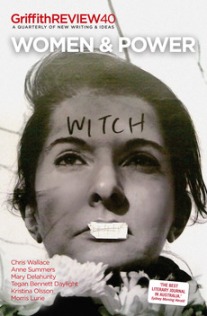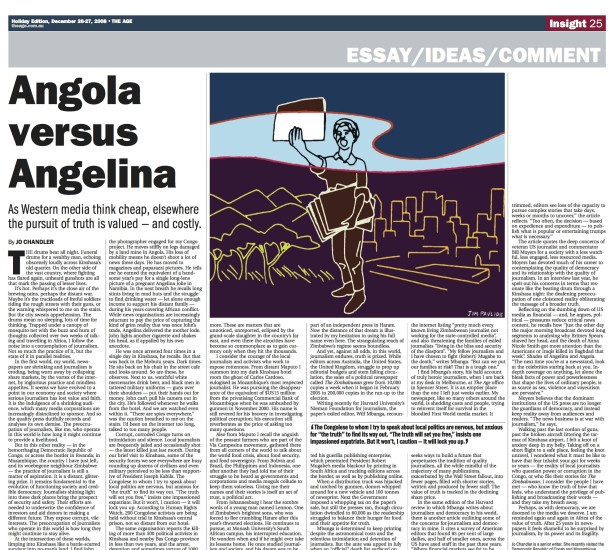MEANJIN: DECEMBER 2022
PNG’S WOMEN IN WAITING
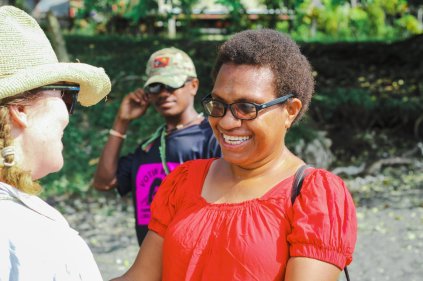 I was lucky to make a couple of reporting trips back to PNG in 2022 (thanks again to the Sean Dorney Grant for Pacific Journalism). One visit coincided with the 2022 election & produced a couple of pieces for The Guardian about women candidates and the push for women’s representation. I came back with lots of thoughts swirling on a decade of conversations on women & power in PNG, and on the limits of outsider journalism in telling their stories. This essay for Meanjin is an attempt to think through some of those issues out loud. It’s a long & rambling read, sorry! and behind a paywall, albeit a modest one. But if you are in PNG with an interest in this, contact me and I can try to share. Big thanks for their generous time & thoughts recently and in the past to Orovu Sepoe Carol Kidu Kessy Sawang Rufina Peter Dulciana SB Tania Bale Matilda Koma Lesley Clark Dorothy Tekwie and the late Nahau Rooney via Michelle Nayahamui Su-Powes & so many more . AND of course this reporting would not have happened without the Walkley Foundation/ Sean Dorney Grant for Pacific Journalism. Photo is of me with successful candidate Kessy Sawang on voting day in her village on the Madang Rai Coast.
I was lucky to make a couple of reporting trips back to PNG in 2022 (thanks again to the Sean Dorney Grant for Pacific Journalism). One visit coincided with the 2022 election & produced a couple of pieces for The Guardian about women candidates and the push for women’s representation. I came back with lots of thoughts swirling on a decade of conversations on women & power in PNG, and on the limits of outsider journalism in telling their stories. This essay for Meanjin is an attempt to think through some of those issues out loud. It’s a long & rambling read, sorry! and behind a paywall, albeit a modest one. But if you are in PNG with an interest in this, contact me and I can try to share. Big thanks for their generous time & thoughts recently and in the past to Orovu Sepoe Carol Kidu Kessy Sawang Rufina Peter Dulciana SB Tania Bale Matilda Koma Lesley Clark Dorothy Tekwie and the late Nahau Rooney via Michelle Nayahamui Su-Powes & so many more . AND of course this reporting would not have happened without the Walkley Foundation/ Sean Dorney Grant for Pacific Journalism. Photo is of me with successful candidate Kessy Sawang on voting day in her village on the Madang Rai Coast.
GRIFFITH REVIEW: APRIL 2022
BURIED TREASURE: JOURNEY INTO DEEP TIME
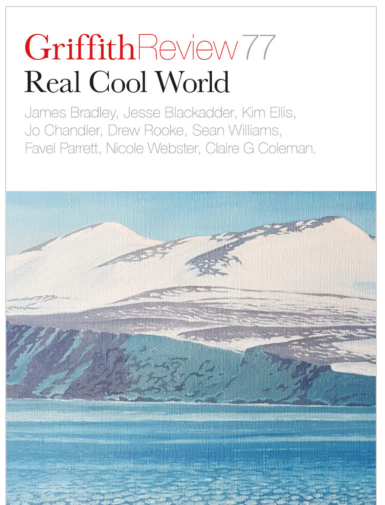 In 2007 and again in 2008/09 I was lucky enough to spend time in Antarctica researching stories on Australia’s scientific work there, reporting on changes to the polar ice and Southern Ocean, and what they can tell us about our climate past and our future. In the years since I have returned to the science many times as knowledge has grown, reporting on the melting of ice sheets, the movement of glaciers, the implications for global sea level rise, and a host of other issues. I’ve developed knowledge and relationships I cherish – it’s a gratifying thing to do as a reporter, to circle back, ideally with new stories informed and enriched by previous work. One of the stories I’ve followed closely over those years is the quest to recover more than one million years of Earth’s climate history by drilling a hole deep into the ice sheet. It’s an epic and urgent mission. I was thrilled to be part of this Antarctic edition of Griffith Review, and to produce this piece with the ever-patient and brilliant guidance of editor Ashley Hay. This was her last edition of GR, and my third longform story for her over the years. You can find the piece in the Griffith Review 77 Real Cool World: Link here: https://www.griffithreview.com/articles/buried-treasure/
In 2007 and again in 2008/09 I was lucky enough to spend time in Antarctica researching stories on Australia’s scientific work there, reporting on changes to the polar ice and Southern Ocean, and what they can tell us about our climate past and our future. In the years since I have returned to the science many times as knowledge has grown, reporting on the melting of ice sheets, the movement of glaciers, the implications for global sea level rise, and a host of other issues. I’ve developed knowledge and relationships I cherish – it’s a gratifying thing to do as a reporter, to circle back, ideally with new stories informed and enriched by previous work. One of the stories I’ve followed closely over those years is the quest to recover more than one million years of Earth’s climate history by drilling a hole deep into the ice sheet. It’s an epic and urgent mission. I was thrilled to be part of this Antarctic edition of Griffith Review, and to produce this piece with the ever-patient and brilliant guidance of editor Ashley Hay. This was her last edition of GR, and my third longform story for her over the years. You can find the piece in the Griffith Review 77 Real Cool World: Link here: https://www.griffithreview.com/articles/buried-treasure/
GRIFFITH REVIEW: FEBRUARY 2021
THE CLIMATE COVID COLLISION: TALES FROM THE FRONT LINE
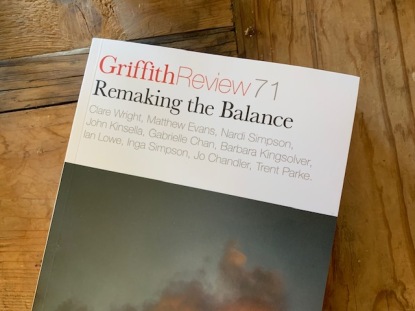 I was supposed to be researching matters of climate justice in the Pacific. Instead over the long Melbourne lockdown in the pandemic winter of 2020, I was in my home nursing a bad case of Black Summer grief. This essay captures my attempts to wrangle that into something useful, going back to scientific experts who are long-haul contacts, digging deep. The piece is published in the latest edition of the quarterly journal Griffith Review: Remaking the Balance. Read it here: https://www.griffithreview.com/articles/tales-from-the-frontline/
I was supposed to be researching matters of climate justice in the Pacific. Instead over the long Melbourne lockdown in the pandemic winter of 2020, I was in my home nursing a bad case of Black Summer grief. This essay captures my attempts to wrangle that into something useful, going back to scientific experts who are long-haul contacts, digging deep. The piece is published in the latest edition of the quarterly journal Griffith Review: Remaking the Balance. Read it here: https://www.griffithreview.com/articles/tales-from-the-frontline/
This essay was selected as runner-up for the 2021 UNSW Bragg Prize for Science Writing.
INSIDE STORY: JUNE 2021
NOT DROWNING, FIGHTING
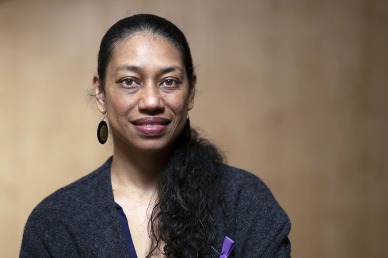 As a serial ‘parachute’ journalist, dropping in & out of places not my own, I’m all too aware of the shortcomings of this model of reporting. Thinking out loud about how to tell truer, deeper stories of climate impacts in the Pacific in this critical moment, I’m grateful for the insights of Katerina Teaiwa and Fiji activist Ernest Gibson in this piece published today in InsideStory.org and The Canberra Times. https://insidestory.org.au/not-drowning-fighting/
As a serial ‘parachute’ journalist, dropping in & out of places not my own, I’m all too aware of the shortcomings of this model of reporting. Thinking out loud about how to tell truer, deeper stories of climate impacts in the Pacific in this critical moment, I’m grateful for the insights of Katerina Teaiwa and Fiji activist Ernest Gibson in this piece published today in InsideStory.org and The Canberra Times. https://insidestory.org.au/not-drowning-fighting/
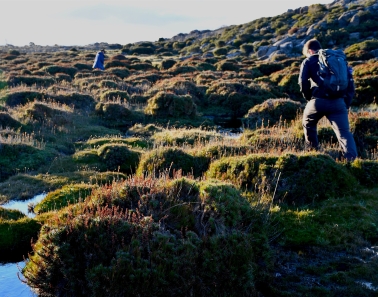 I was deeply honored to be invited to contribute to this collection published NewSouth book ‘Living with the Anthropocene: Love, Loss & Hope in the Face of Environmental Crisis’. The book is a thoughtful, energising, informing collection including voices like Tony Birch, James Bradley, Sophie Cunningham, Delia Falconer, Jane Rawson and more. Honoured to be part of it. Meanwhile you can read my contribution free online here thanks to Inside Story. Big thanks again to Prof David Bowman and Ben French and the team.
I was deeply honored to be invited to contribute to this collection published NewSouth book ‘Living with the Anthropocene: Love, Loss & Hope in the Face of Environmental Crisis’. The book is a thoughtful, energising, informing collection including voices like Tony Birch, James Bradley, Sophie Cunningham, Delia Falconer, Jane Rawson and more. Honoured to be part of it. Meanwhile you can read my contribution free online here thanks to Inside Story. Big thanks again to Prof David Bowman and Ben French and the team.MARGARET MEAD’S MANUS: The Guardian and The Monthly (2014)
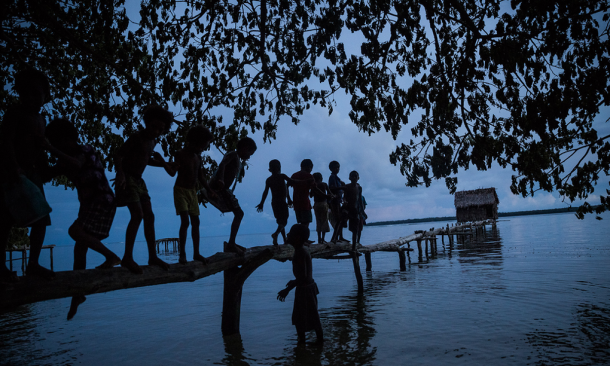
Picture: Vlad Sokhin
In late 2014 I spent 10 days on Manus Island, and several months researching issues relating to Manus, to produce two long-form articles reflecting on the story of this island beyond its context as a detention centre for Australia’s unwanted. At that time Manus Island in the Australian media landscape and popular imagination was little more than a mysterious compound of barbed wire. My interest was in the reality outside the wire – on how Australian policy had changed life for the people on this island. It was a fascinating project, dipping a toe into this so complex, so scrutinised, and yet so unknown society. One article was published in The Monthly magazine, which reflects a little on anthropologist Margaret Mead’s long involvement with the island, and another in The Guardian Australia.
Reporting of this series made possible by an independently awarded grant from GetUps Shipping News project. By Jo Chandler/ Pics Vlad Sokhin. Link here.
THE LOWY INSTITUTE: 2014
HOW MEN ARE GETTING AWAY WITH MURDER IN PAPUA NEW GUINEA
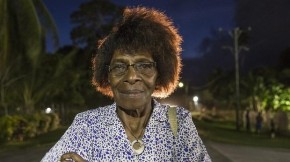
In this long analysis published by the Lowy Institute, I draw on travels and storytelling in PNG over several years, incorporating fresh interviews and older notebooks and expert insights of PNG commentators, specialists and anthropologists to explore a range of questions around the endemic violence against women in Papua New Guinea. My principle concern is to explain to a wider readership how, and why, justice is still so elusive for victims of violence in PNG. Full report here. Picture: Sophie Mangai, by Vlad Sokhin.
GRIFFITH REVIEW: 2013
WOMEN & POWER: ‘TAIM MILONG OL MERI’
‘Even the architecture of power in modern PNG conspired to lock women out. Custom banned women from entering, or even approaching, the Haus Tambaran, as the Parliament is colloquially known. Nevertheless, intriguingly, the mosaic over the public entrance to the Parliament depicts two warriors – one male, one female – of equal size, and on equal footing, standing guard over the country’s resources. This was likely an expression of aspiration … Today it just smacks of cruel delusion.”
Link: https://griffithreview.com/articles/taim-bilong-ol-meri/
GRIFFITH REVIEW: 2013
Tasmania: ‘The Science Laboratory’
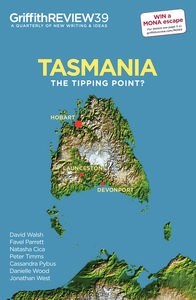 ‘But in science, geography is merely the catalyst. A trawl through the archives of Tasmania’s scientific heritage reveals that while it may determine the climate of the enterprise, other forces materialise to influence the weather. A handful of dynamic, brilliant characters attracted by the opportunity to pursue their own obsessions in turn capture and enthuse students and dreamers, bequeathing traditions and institutions that continue to evolve … Geography, aspiration, inspiration, economy and serendipity collude and, to be unscientific, magic happens.’
‘But in science, geography is merely the catalyst. A trawl through the archives of Tasmania’s scientific heritage reveals that while it may determine the climate of the enterprise, other forces materialise to influence the weather. A handful of dynamic, brilliant characters attracted by the opportunity to pursue their own obsessions in turn capture and enthuse students and dreamers, bequeathing traditions and institutions that continue to evolve … Geography, aspiration, inspiration, economy and serendipity collude and, to be unscientific, magic happens.’
Link: https://griffithreview.com/articles/the-science-laboratory/
THE AGE AND SYDNEY MORNING HERALD 2009
WALKLEY AWARD WINNER: All media/ Commentary, Critique and Analysis
‘The elegance of Jo Chandler’s prose and the passion behind each word makes these pieces utterly compelling. This is empathetic journalism at its finest. She has aired voices which could not be heard in their own country and has brought them to vivid life. Refreshingly, Chandler has found a new way to persuade us to engage with Third World oppression and suffering. A good read. ‘
Click here to see to full judges reports and full package of stories.
